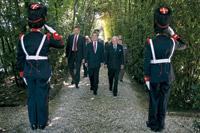Website: https://vaticannewworldorder.blogspot.com/2012/04/order-of-malta-knights-of-st-jhon-of.html
The Jesuit Vatican New World Order
YOUTUBE CHANNEL - Alan Lamont New Youtube Channel SKYPE USERNAME - Alan Lamont
Friday, 27 April 2012
KNIGHTS OF MALTA ORDER OF MALTA CLICK ON VIDEO TITLE TO WATCH ON YOUTUBE KNIGHTS OF ST JOHN OF JERUSALEM
CLICK ON THIS LINK AMERICA TO SEE THE SMOM GLOBAL NETWORK America

Multilateral relations
The Order of Malta has permanent observer missions to the United Nations and its specialized agencies:
United Nations – New York
United Nations – Geneva
United Nations – Vienna
ESCAP – United Nations Economic and Social Commission for Asia and the Pacific - (Bangkok)
FAO – Food and Agricultural Organization of the United Nations – (Rome)
IAEA – International Atomic Energy Agency – (Vienna)
IFAD – International Fund for Agricultural Development - (Rome)
UNEP – United Nations Environment Programme – (Nairobi)
UNESCO – United Nations Educational, Scientific and Cultural Organization – (Paris)
UNHCHR – United Nations High Commissioner for Human Rights - (Geneva)
UNHCR – United Nations High Commissioner for Refugees - (Geneva)
UNIDO – United Nations Industrial Development Organization – (Vienna)
WFP – World Food Programme of the United Nations – (Rome)
WHO – World Health Organization - (Geneva)
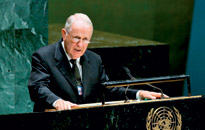

The Order of Malta has delegations or representations to international organizations:
CTBTO- Preparatory Commission for the comprehensive nuclear-test-ban Treaty Organization – (Vienna)
ICCROM – International Centre for the study of the preservation and restoration of cultural property – (Rome)
ICMM - International Committee of Military Medicine – (Brussels)
ICRC – International Committee of the Red Cross – (Geneva)
IDB – Inter-American Development Bank – (Washington D.C.)
IIHL – International Institute of Humanitarian Law – (Sanremo, Geneva)
IFRC -International Federation of Red Cross and Red Crescent Societies – (Geneva)
IOM – International Organization for Migration - (Geneva)
UNIDROIT – International Institute for the Unification of Private Law - (Rome)
UNILAT- Latin Union - (Santo Domingo, Paris)
Council of Europe – (Strasbourg)
The Prince and Grand Master
The Grand Master is elected for life from the Professed Knights by the Council Complete of State. According to the Constitution, as the religious Superior and Sovereign, he must fully dedicate himself to the development of the works of the Order and to set an example of living by Christian principles, to all the members of the Order. He is vested with supreme authorities. Together with the Sovereign Council, the Grand Master issues the legislative measures not covered by the Constitutional Charter, promulgates government acts, manages Common Treasure assets, ratifies, international agreements and the summoning of the Chapter General. The States with which the Order has diplomatic relations recognise the Grand Master with the prerogatives, immunities and honours reserved for Heads of State. He is bestowed the title of Most Eminent Highness, and the Holy Roman Church confers him the rank of Cardinal. The Grand Master resides at the Order's seat of government in Via Condotti in Rome.
Profile of His Most Eminent Highness the Prince and Grand Master Fra’ Matthew FESTING
Fra’ Matthew Festing, an Englishman, was elected Prince and Grand Master of the Order of Malta on 11th March 2008 by the Council Complete of State of the Order of Malta. He succeeds Fra’ Andrew Bertie, 78th Grand Master (1988-2008), who died on 7 February.
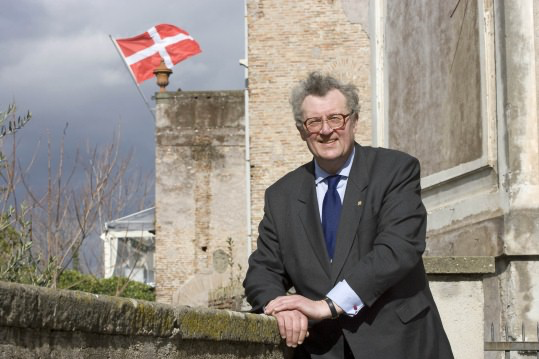
Born in Northumberland on 30 november 1949, educated at Ampleforth and St. John's College Cambridge, where he read history, Fra’ Matthew, an art expert, has for most of his professional life worked at an international art auction house. As a child he lived in Egypt and Singapore, where his father, Field Marshal Sir Francis Festing, Chief of the Imperial General Staff, had earlier postings. He is also descended from Sir Adrian Fortescue, a knight of Malta, who was martyred in 1539.
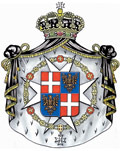
The Coat of Arms of Grand Master Festing
Fra’ Matthew Festing served in the Grenadier Guards and holds the rank of colonel in the Territorial Army. He was appointed OBE (Officer of the Order of the British Empire) by the Queen and served as her Deputy Lieutenant in the county of Northumberland.
He became a member of the Sovereign Order of Malta in 1977, and took solemn religious vows in 1991, becoming a Professed Knight of the Order. Between 1993 and 2008 he was the Grand Prior of England. In this capacity, he has led missions of humanitarian aid to Kosovo, Serbia and Croatia after the recent disturbances in those countries, and he attends the Order's international annual pilgrimage to Lourdes.
As well as his passion for the decorative arts and for history, his encyclopaedic knowledge of the history of the Order of Malta is well known.
Government
- Grand Master
- Grand Commander
- Grand Chancellor
- Grand Hospitaller
- Receiver of the Common Treasure
- Government Bodies
- Flags
- Emblems
- Order Pro Merito Melitensi
- Constitutional Charter and code (pdf, 1.25 MB) MUST READ (as of June 2021 this statement is posted:)
"Something appears to have gone horribly wrong."
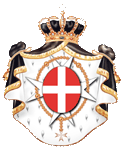
The Sovereign Order of Malta is a sovereign subject of international law. The Order - which is based in Rome, in via Condotti - has its own Government, an independent magistracy, bilateral diplomatic relations with 104 countries and is granted the status of Permanent Observer in many international organisations, such as the United Nations. Its operational activities are managed by the six Grand Priories, six Subpriories and 47 National Associations of Knights in the five continents. The Order issues its own passports and stamps and creates public institutions, endowed with independent juridical personality. Order's life is governed by the Constitutional Charter and the Code, reformed in 1997. The Grand Master governs the Order both as sovereign and religious head. He is elected for life, within the professed knights in perpetual vows. He is assisted by and presides over the Sovereign Council, which is composed of four high offices - Grand Commander, Grand Chancellor, Grand Hospitaller, and Receiver of the Common Treasure - as well as six other members, all elected by the Order's Chapter General for a five-year term. The Council of Government and the Board of Auditors, whose compositions reflect the international character of the Order, assist the Grand Master and the Sovereign Council. The Chapter General also elects these two bodies for a five-year term.
The legal system of the Order is expressed by the usual division into three powers:
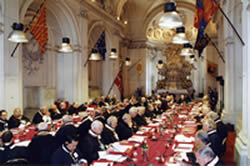
Legislative power
Rests with the Grand Master and Sovereign Council for non-constitutional matters; with the Chapter General, representing the Supreme Assembly of Knights, as far as constitutional rules are concerned.
Executive power
Rests with the Sovereign Council, chaired by the Grand Master and composed of ten Knights elected by the Chapter General.
Judicial power
It is exercised by the Magistral Courts of First Instance and of Appeal, composed of judges appointed by the Grand Master and the Sovereign Council from Order members of legal expertise.
Government Bodies
Council Complete of State
The Council Complete of State meets to elect the Grand Master or the Lieutenant of the Grand Master. The election of the Grand Master requires a majority plus one of those present entitled to vote, as provided for in Art. 23 of the Order of Malta Constitution. Among the holders of voting rights are the Lieutenant of the Grand Master or Interim Lieutenant, the members of the Sovereign Council, the Prelate, the Priors, the professed Bailiffs, two professed Knights delegated by each Priory and fifteen representatives of the National Associations.
Chapter General
The Chapter General represents the Supreme Assembly of Knights and meets every five years to elect the members of the Sovereign Council, the Government Council and the Board of Auditors, to amend the Constitution and Code as appropriate and to discuss important issues such as spiritual status, the humanitarian activities programme and international relations of the Order. It is composed, among others, of representatives of Order bodies in the world: Grand Priories, Subpriories and National Associations.
Sovereign Council
The Sovereign Council is the government of the Order. It is composed of the Grand Master, the holders of the four High Offices (Grand Commander, Grand Chancellor, Grand Hospitaller and Receiver of the Common Treasure) and six other members. Apart from the Grand Master, they are elected by the Chapter General, by a majority of the Knights present. The Sovereign Council is called by the Grand Master and meets at the seat of the Order at least six times a year and whenever special circumstances require it.
Government Council
This is the advisory board to the Sovereign Council in charge of studying political, religious, humanitarian assistance and international issues. It is convened and chaired by the Grand Master and is composed of six Councillors from various geographical regions elected by the Chapter General among Knights in the three Classes of the Order. It meets at least twice a year.
Board of Auditors
Is in charge of overseeing and auditing the income, the expenditures and all the assets of the Order. It consists of a President, four ordinary Councillors and two alternates, elected by the Chapter General, from amongst Knights with particular expertise in legal, economic and financial disciplines. It also serves as an advisory board of the Receiver of the Common Treasure.
Communications Board
The Communication Board supervises the internal and external communication activities of the Order and assists the Grand Chancellor in the development and implementation of communication programmes. It is composed of a President and six Councillors chosen from members of the Order, competent in various sectors of communication, management, public relations and mass-media.
Juridical Council
This is an expert advisory collegial body that may advise the Grand Master, subject to consultation with the Sovereign Council, on relevant legal issues. It meets at the seat of the Order and is composed of a Chairman, a Vice-Chairman, a Secretary General and four members.
These are appointed by the Grand Master with the advice of the Sovereign Council ideally from members of the Order, and are law experts, particularly in Order Law, public and international law and Canon Law.
Magistral Courts
Pursuant to the Code, the Magistral Courts exercise the jurisdictional function of court of first resort and of appeal. The Presidents of the Court, the Justices and the Chancellor are appointed by the Grand Master, with the deciding vote of the Sovereign Council, among Order members with legal expertise. Trial procedures, except for directives set forth by the Code, are subject to the rules of civil procedure of the State of the Vatican City. Upon written request of States or international law entities, the Magistral Courts may also act as an arbitration venue for international controversies.
The Office of Advocate General
The Office of Advocate General provides legal assistance pursuant to the Code and is made up of independent members of the legal profession of eminent repute who are experts in law and versed in the traditions and customs of the Order. It is composed of the Advocate General and two alternates who are appointed by the Grand Master with the Sovereign Council for a period of three years renewable. The organisations of the Order should seek the advice and the assistance of the Office of the Advocate General whenever necessary and especially in cases which involve complex legal issue.
Receiver of the Common Treasure
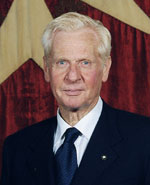
The Receiver of the Common Treasure - the Minister of Finance - directs the administration of the finances and the property of the Order in coordination with the Grand Chancellor, under the authority of the Grand Master and the surveillance of the Board of Auditors. He is responsible for drawing up the annual accounts, relating to the economic and financial state of the Order, submitting them to the Board of Auditors and to the Grand Master, with the advice of the Sovereign Council, for approval. Also with the advice of the Sovereign Council, he submits to the Grand Master for approval the acceptance of inheritances, bequests and donations, and the disposal and subsequent reinvestment of the goods of the Order. He manages and supervises the Magistral Postal Service and, through the Secretary General , the internal services of the Magistral household, the Personnel Office of the Grand Magistry, the Office of Technical Services and the superintendence of the Magistral Palace and related buildings. With the mandate of the Grand Master, the Receiver also supervises the administration of the organisations and works of the Order. He is the counter-signatory for acts of disposal or assignment and contracts which involve the property of the Grand Magistry and the Priories.
Profile of the Receiver of the Common Treasure
H.E. Marchese Gian Luca CHIAVARI
Bailiff Grand Cross of Honour and Devotion in Obedience
Gian Luca Chiavari was born in Rome on January 11, 1935, to H.E Ambassador to the Italian Republic Marquis Gian Gerolamo Chiavari and Marquise Laura Pallavicino. Married to Marchesa Elena Cattaneo della Volta di Belforte, Dame Grand Cross of Honour and Devotion in Obedience of the Order of Malta, he has three children: Fabiano, Violantina and Giacomo. He graduated with honours in Business Administration from the University of Genova and was the Italian delegate to the International Associations of Students of Business Administration. He served in the military as Officer of the Cavalry Regiment of Genova.
Until 1994 he was a member of the Executive Committee of the Shell Group in Italy and worked abroad for many years with this company. Admitted to the Sovereign Military Order of Malta in 1979, made the Promise of Obedience in 1983. Elected Receiver of the Common Treasure at the 1999 Chapter General, re-elected in 2004 and in 2009. Counsellor of the Pilgrimages of the Italian Language and of the Committee for Pilgrimages to Lourdes. Has also been Counsellor of the Italian Association and member of the Council for Communications of the Order. He is Vice President of the Corps of Italian Nobility and President Emeritus of the Association of Nobles of Liguria.
The 79 Grand Masters
1
Blessed Gerard
![]() Sept. 3 1120
Sept. 3 1120
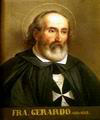
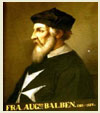
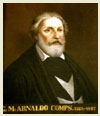
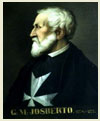
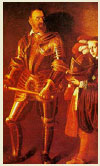
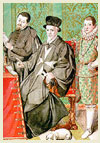
2
Fra' Raymond du Puy
1120 - c. 1158/60
3
Fra' Auger de Balben
c. 1158/60 - 1162/3
4
Fra' Arnaud de Comps
1162 - 1163
5
Fra' Gilbert de Aissailly
1163 - c.1169/70
6
Fra' Gastone de Murols
c. 1170 - c. 1172
7
Fra' Gilbert
c. 1172 - 1177
8
Fra' Roger de Moulins
1177 - c. 1187
9
Fra' Hermangard d'Asp
1188 - c. 1190
10
Fra' Garnier de Naplous
1189/90 - 1192
11
Fra' Geoffroy de Donjon
1193 - 1202
12
Fra' Alfonse of Portugal
1203 - 1206
13
Fra' Geoffrey le Rat
1206 - 1207
14
Fra' Garin de Montaigu
1207 - c. 1227/8
15
Fra' Bertrand de Thessy
c. 1228 - 1231
16
Fra' Guerin
1231 - 1236
17
Fra' Bertrand de Comps
1236 - c. 1239/40
18
Fra' Pierre de Vielle-Bride
1239/40 - 1242
19
Fra' Guillaume de Chateauneuf
1242 - 1258
20
Fra' Hugues de Revel
1258 - 1277
21
Fra' Nicolas Lorgne
1277/8 - 1284
22
Fra' Jean de Villiers
1284/5 - c. 1293/4
23
Fra' Odon de Pins
1294 - 1296
24
Fra' Guillaume de Villaret
1296 - 1305
25
Fra' Foulques de Villaret
1305 - 1319
26
Fra' Helion de Villeneuve
1319 - 1346
27
Fra' Dieudonné de Gozon
1346 - 1353
28
Fra' Pierre de Corneillan
1353 - 1355
29
Fra' Roger de Pins
1355 - 1365
30
Fra' Raymond Berenger
1365 - 1374
31
Fra' Robert de Juliac
1374 - 1376
32
Fra' Jean Fernandez de Heredia
1376 - 1396
33
Fra' Riccardo Caracciolo
1383 - 1395
34
Fra' Philibert de Naillac
1396 - 1421
35
Fra' Antonio Fluvian de Riviere
1421 - 1437
36
Fra' Jean de Lastic
1437 - 1454
37
Fra' Jacques de Milly
1454 - 1461
38
Fra' Piero Raimondo Zacosta
1461 - 1467
39
Fra' Giovanni Battista Orsini
1467 - 1476
40
Fra' Pierre d'Aubusson
1476 - 1503
41
Fra' Emery d'Amboise
1503 - 1512
42
Fra' Guy de Blanchefort
1512 - 1513
43
Fra' Fabrizio del Carretto
1513 - 1521
44
Fra' Philippe de Villiers de l'Isle-Adam
1521 - 1534
45
Fra' Piero de Ponte
1534 - 1535
46
Fra' Didier de Saint-Jaille
1535 - 1536
47
Fra' Jean de Homedes
1536 - 1553
48
Fra' Claude de la Sengle
1553 - 1557
49
Fra' Jean de la Vallette (or Valette)
1557 - 1568
50
Fra' Pierre de Monte
1568 - 1572
51
Fra' Jean de la Cassiere
1572 - 1581
52
Fra' Hugues Loubenx de Verdala
1581 - 1595
53
Fra' Martin Garzez
1595 - 1601
54
Fra' Alof de Wignacourt
1601 - 1622
55
Fra' Luis Mendez de Vasconcellos
1622 - 1623
56
Fra' Antoine de Paule
1623 - 1636
57
Fra' Juan de Lascaris-Castellar
1636 - 1657
58
Fra' Antoine de Redin
1657 - 1660
59
Fra' Annet de Clermont-Gessant
1660
60
Fra' Raphael Cotoner
1660 - 1663
61
Fra' Nicolas Cotoner
1663 - 1680
62
Fra' Gregorio Carafa
1680 - 1690
63
Fra' Adrienne de Wignacourt
1690 - 1697
64
Fra' Ramon Perellos y Roccaful
1697 - 1720
65
Fra' Marc'Antonio Zondadari
1720 - 1722
66
Fra' Antonio Manoel de Vilhena
1722 - 1736
67
Fra' Raymond Despuig
1736 - 1741
68
Fra' Manuel Pinto de Fonseca
1741 - 1773
69
Fra' Francisco Ximenes de Texada
1773 - 1775
70
Fra' Emmanuel de Rohan-Polduc
1775 - 1797
71
Fra' Ferdinand von Hompesch zu Bolheim
1797 - 1802
72
Emperor Paul I of Russia (de facto)
1799 - 1801
73
Fra' Giovanni Battista Tommasi
1803 - 1805
74
Fra' Giovanni Battista Ceschi a Santa Croce
1879 - 1905
75
Fra' Galeazzo von Thun und Hohenstein
1905 - 1931
76
Fra' Ludovico Chigi Albani della Rovere
1931 - 1951
77
Fra' Angelo de Mojana di Cologna
1962 - 1988
78
Fra' Andrew Willoughby Ninian Bertie
1988 - 2008
79
Fra' Matthew Festing
2008 -
LIEUTENANTS OF THE GRAND MAGISTRY
1
Fra' Innico Maria Guevara-Suardo
1805-1814
2
Fra' André Di Giovanni
1814-1821
3
Fra' Antoine Busca
1821-1834
4
Fra' Carlo Candida
1834-1845
5
Fra' Philippe di Colloredo-Mels
1845-1864
6
Fra' Alessandro Borgia
1865-1872
7
Fra' Giovanni Battista Ceschi a Santa Croce
1872-1879
8
Fra' Antoine Hercolani Fava Simonetti "ad interim"
1951-1955
9
Fra' Jean Charles Pallavicini "ad interim"
1988 (January-April)
10
Fra’ Giacomo Dalla Torre del Tempio di Sanguinetto
2008 (February-March)
LIEUTENANTS OF THE GRAND MASTER
Fra' Pio Franchi de' Cavalieri
(during 75th Grand Master's illness)
1929-1931
Fra' Ernesto Paternò Castello di Carcaci
1955-1962
Medical and humanitarian activities
Medical and humanitarian activities of the British Association
Medical and Humanitarian activities of the Order of Malta
Bilateral relations with countries
The Order and its Institutions
Conventual Church of the Order
Contact Us
Contact Us
Links
History
960 years of history
The 79 Grand Masters
Names of the Order
The British Association
The Grand Priory of England
The English Langue
Mimic orders
Around the World
Europe
Africa
America
Asia
Oceania
Picture Gallery
View gallery
Bilateral relations with countries
Home > Diplomatic relations > Bilateral relations with countries
Bilateral relations with countries
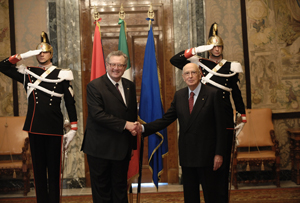
The diplomatic activities of the Order are closely linked to its humanitarian mission: the presence of accredited diplomatic missions in more than 100 countries of the world supports the activities of the Order. In the international political field, the Order of Malta is neutral, impartial and non-political. Because of these characteristics, the Order can act as a mediator whenever a State requests its intervention to settle a dispute.
The Order has steadily increased its diplomatic relations in recent years. Today the Order has Diplomatic Missions in 104 countries – many of which are non-Catholic – and missions to some European countries, as well as to European and international organisations.
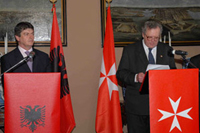
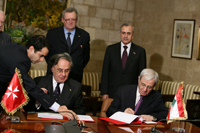
The Order of Malta has diplomatic relations with 104 countries:
Europe
Albania
Austria
Belarus
Bosnia-Herzegovina
Bulgaria
Croatia
Czech Republic
Holy See
Hungary
Italy
Latvia
Liechtenstein
Lithuania
Macedonia (Former Yugoslav Republic of)
Malta
Moldova
Monaco
Montenegro
Poland
Portugal
Romania
Russia, Federation of*
San Marino
Serbia
Slovakia
Slovenia
Spain
Ukraine
The Americas
Antigua and Barbuda
Argentina
Bahamas, The
Belize
Bolivia
Brazil
Chile
Colombia
Costa Rica
Cuba
Dominican Republic
Ecuador
El Salvador
Guatemala
Guyana
Haiti
Honduras
Nicaragua
Panama
Paraguay
Peru
Saint Lucia
Saint Vincent and the Grenadines
Suriname
Uruguay
Venezuela
Asia
Afghanistan
Armenia
Cambodia
Georgia
Jordan
Kazakhstan
Lebanon
Philippines
Tajikistan
Thailand
Timor-Leste
Turkmenistan
Africa
Angola
Benin
Burkina Faso
Cameroon
Cape Verde
Central Africa
Chad
Comoros
Congo, Democratic Republic of the
Congo, Republic of the
Côte d’Ivoire
Egypt
Equatorial Guinea
Eritrea
Ethiopia
Gabon
Guinea
Guinea-Bissau
Kenya
Liberia
Madagascar
Mali
Mauritania
Mauritius
Morocco
Mozambique
Namibia
Niger
Sao Tome and Principe
Senegal
Seychelles
Sierra Leone
Somalia
Sudan
Togo
Oceania
Micronesia
Marshall Islands
Kiribati
* Relations with these countries are maintained through a diplomatic special mission.
The Order of Malta also has official
relations with:
- Belgium
- France
- Germany
- Luxembourg
- Switzerland
- Canada
The Order of Malta has relations at Ambassador level with:
- Palestinian Authority
Home Contact Us FAQ In Britain
![]()
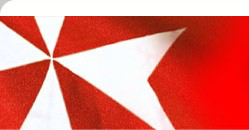

International Organizations
INTERNATIONAL HOSPITALLER COMMITTEE OF THE ORDER OF MALTA
The International Hospitaller Committee of the Order of Malta coordinates the international activities of the Order’s national associations and organizations. Its mission is to promote the activities of the Order and the identity of its institutions which operate at the international level, in accordance with the Order’s mission. It is presided over by the Grand Hospitaller and has its headquarters in the Magistral Palace in Rome.
MALTESER INTERNATIONAL
Malteser International is the Order of Malta’s international relief organisation for medical and humanitarian aid. Its worldwide operations include emergency medical interventions, long term reconstruction and development programmes. Since 2005, Malteser International has replaced ECOM (Emergency Corps of the Order of Malta). A new structure, but with more than 50 years experience in humanitarian operations.
There are 20 Order of Malta Associations belonging to Malteser International: Austria, Belgium, France, Canada, Germany, Great Britain, Ireland, Italy, Malta, the Netherlands, Poland, Portugal, Switzerland, Hungary, Mexico, Australia, Singapore and the three Associations in the United States of America.
Malteser International – which currently runs missions in 30 countries – has its headquarters in Cologne, Germany.
For further information on Malteser International:
www.malteser-international.org
CIOMAL, INTERNATIONAL COMMITTEE OF THE ORDER OF MALTA
CIOMAL, the International Committee of the Order of Malta, was created in 1958 and for 50 years has been fighting leprosy and helping those marginalised by society as a result of having the disease. CIOMAL’s two major current projects are in South East Asia and South America. CIOMAL finances and manages the care centres where prevention, medical assistance, social rehabilitation and medical staff training are organised in collaboration with the government of the hosting country. Today, due to the availability of new medical treatments, important results have been achieved in the battle against the disease. Leprosy will eventually disappear as a life-threatening illness, but in the meantime, CIOMAL continues to offer medical care to sufferers in the countries at risk. To date, 17,000 leprosy patients have been cured. CIOMAL, which has headquarters in Geneva, is affiliated to the International Federation of Anti-Leprosy Associations and collaborates with the World Health Organisation; its programmes are carried out in accordance with their directives.
INTERNATIONAL ASSOCIATION OF CATHOLIC BIOETHICISTS
The new challenges posed by controversial and emerging questions in Bioethics brought various national Associations of the Order of Malta to create the International Association of Catholic Bioethicists, whose mission is to promote and foster cooperation among Catholic bioethicists. By creating a network for international collaboration, the IACB seeks to increase the capacity of Catholic bioethicists to participate in public discussions and to promote ethics in health care and research globally.
Bioethicists associated with the IACB join a community of supportive peers, receive information relevant to their work, and participate in IACB-sponsored events and projects such as an international colloquium every two years; national and regional colloquia; collaborations in education, research and publications.
IACB was launched in Toronto in August 2003, during the 1st International colloquium on “Globalization and the Culture of Life” organised by the Canadian Association of the Order of Malta and the Canadian Catholic Bioethics Institute in Toronto: 57 bioethicists from 19 countries on five continents participated. In 2004 the secretariat was set up in Toronto with the support of several national Associations of the Order of Malta. Since then, three other International Colloquia have been held in different countries, the most recent in Cologne in July 2009. A fifth one is scheduled for 2011.
For more information, please visit:
960 Years of history
1048 Jerusalem
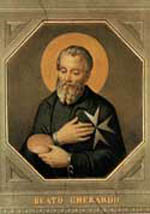
The birth of the Order dates back to around 1048. Merchants from the ancient Marine Republic of Amalfi obtained from the Caliph of Egypt the authorisation to build a church, convent and hospital in Jerusalem, to care for pilgrims of any religious faith or race. The Order of St.John of Jerusalem - the monastic community that ran the hospital for the pilgrims in the Holy Land - became independent under the guidance of its founder, Blessed Gérard. With the Bull of 15 February 1113, Pope Paschal II approved the foundation of the Hospital and placed it under the aegis of the Holy See, granting it the right to freely elect its superiors without interference from other secular or religious authorities. By virtue of the Papal Bull, the Hospital became an Order exempt from the Church. All the Knights were religious, bound by the three monastic vows of poverty, chastity and obedience.
The constitution of the Kingdom of Jerusalem regarding the crusades obliged the Order to take on the military defence of the sick, the pilgrims and the territories that the crusaders had conquered from the Moslems. The Order thus added the task of defending the faith to that of its hospitaller mission.
As time went on, the Order adopted the white eight-pointed Cross that is still its symbol today.
1310 - Rhodes
When the last Christian stronghold in the Holy Land fell in 1291, the Order settled first in Cyprus and then, in 1310, led by Grand Master Fra' Foulques de Villaret, on the island of Rhodes.
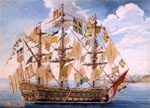
From then, the defence of the Christian world required the organisation of a naval force. Thus the Order built a powerful fleet and sailed the Eastern Mediterranean, fighting many famous battles for the sake of Christendom - for example, the Crusades in Syria and Egypt. From its beginning, the independence from other nations granted by Pontifical deed, and the universally recognised right to maintain and deploy armed forces, constitute the grounds for the international sovereignty of the Order.
In the early 14th century the institutions of the Order and the knights who came to Rhodes from every corner of Europe were grouped according to the languages they spoke. There were initially seven groups of Langues (Tongues): Provence, Auvergne, France, Italy, Aragon (Navarre), England (with Scotland and Ireland) and Germany. In 1492 Castille and Portugal split off from the Langue of Aragon and constituted the eighth Langue. Each Langue included Priories or Grand Priories, Bailiwicks and Commanderies.
The Order was governed by its Grand Master (the Prince of Rhodes) and Council, minted its own money and maintained diplomatic relations with other States. The senior positions of the Order were given to representatives of different Langues. The seat of the Order, the Convent, was composed of religious of various nationalities.
1530 - Malta
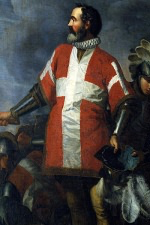
After six months of siege and fierce combat against the fleet and army of Sultan Suleiman the Magnificent, the Knights were forced to surrender in 1523 and left Rhodes with military honours.
The Order remained without a territory of its own until 1530, when Grand Master Fra' Philippe de Villiers de l'Isle Adam took possession of the island of Malta, granted to the Order by Emperor Charles V with the approval of Pope Clement VII.
It was established that the Order should remain neutral in any war between Christian nations. In 1565 the Knights, led by Grand Master Fra' Jean de la Vallette (after whom the capital of Malta, Valletta, was named), defended the island for more than three months during the Great Siege by the Turks.
1571 - The Battle of Lepanto
The fleet of the Order, then one of the most powerful in the Mediterranean, contributed to the ultimate destruction of the Ottoman naval power in the Battle of Lepanto in 1571.
1798 - In exile
Two hundred years later, in 1798, Napoleon Bonaparte occupied the island for its strategic value during his Egyptian campaign. Because of the Order’s Rule prohibiting them to raise weapons against other Christians, the knights were forced to leave Malta. Although the sovereign rights of the Order in the island of Malta had been reaffirmed by the Treaty of Amiens (1802), the Order has never been able to return to Malta.
1834 - Rome
After having temporarily resided in Messina, Catania and Ferrara, in 1834 the Order settled definitively in Rome, where it owns, with extraterritoriality status, the Magistral Palace in Via Condotti 68 and the Magistral Villa on the Aventine Hill.
The 20th and 21th Century

The original hospitaller mission became once again the main activity of the Order, growing ever stronger during the last century, most especially because of the contribution of the activities carried out by the Grand Priories and National Associations in so many countries around the world. Large-scale hospitaller and charitable activities were carried out during World Wars I and II under Grand Master Fra' Ludovico Chigi Albani della Rovere(1931-1951). Under the Grand Masters Fra’ Angelo de Mojana di Cologna (1962-1988) and Fra' Andrew Bertie (1988-2008), the projects expanded until they reached the furthermost regions of the planet.
To discover more about the current activities of the Order, please visit the Medical and humanitarian activities section of this web site.
Mission
Mission of the Order
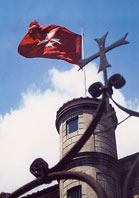
The Order of St John of Jerusalem is one of the oldest institutions of Western and Christian civilisation. Present in Palestine in around 1050, it is a lay religious Order, traditionally of military, chivalrous, noble nature. Its 13,000 members include Professed Friars and others who have made vows of obedience. The other Knights and Dames are lay members, devoted to the exercise of Christian virtue and charity. What distinguishes the Knights of Malta is their commitment to reaching their spiritual perfection within the Church and to expending their energies serving the poor and the sick.
The Order of Malta remains true to its inspiring principles, summarised in the motto "Tuitio Fidei et Obsequium Pauperum", defence of the Faith and assistance to the poor and the suffering, which become reality through the voluntary work carried out by Dames and Knights in humanitarian assistance and medical and social activities. Today the Order carries out these activities in over 120 countries.
Characteristics of the Order
The Sovereign Order of Malta is a sovereign subject of international law, with its own constitution, passports, stamps, and public institutions. The 79th Grand Master, Fra' Matthew Festing, was elected Head of the Order for life on March 11th 2008. The Order has diplomatic relations with 104 countries - many of which non-Catholic - and missions to major European countries, as well as to European and international organisations. The Order of Malta is neutral, impartial and non-political, which is why it can successfully act as a mediator between States.
The Order and the Republic of Malta
The Order has recently returned to Malta, after signing an agreement with the Maltese Government which granted the Order the exclusive use of Fort St. Angelo for a term of 99 years. Located in the town of Birgu, the Fort belonged to the Knights from 1530 until the island was occupied by Napoleon in 1798. Today, after restoration, the Fort hosts historical and cultural activities related to the Order of Malta.
The Grand Priory of England
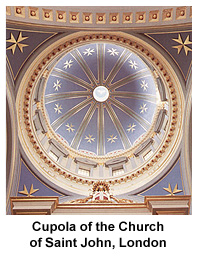
There were English knights of the Hospital from the time of the First Crusade, long before the foundation of the English Langue in the early years of the fourteenth century. In the English Langue were knights from England, Wales, Scotland and Ireland. Around 1144, two priories were established, one for England, Wales and Scotland, and another for Ireland. The superior was the Prior at Clerkenwell, whose territory also included a commandery in Wales. The Prior of Ireland, whose grand commandery was at Kilmainham, came under Clerkenwell's jurisdiction, though this was not always very effective as Irish brethren sometimes became involved in their country's internal wars. Scotland had only one commandery, Torphichen, in Midlothian, whose incumbent was known as "Prior of Scotland," though he was subordinate to Clerkenwell.
The Prior of England, "My Lord of Saint John's," given precedence before all lay barons, was an important figure in English life. Like the rest of the Order, the Grand Priory of England received a great accession of wealth and property when the Templars were suppressed in 1312.
In Scotland the Commander of Torphichen, the "Lord of Saint Johns" sat in Parliament until 1563. The heir of the last commander still sits in Parliament as Lord Torphichen.
In 1380, a Prior of England, Robert Hales, became Treasurer to Richard II. His poll tax proved unpopular, provoking the Peasants' Revolt in 1381. Clerkenwell was burned and Robert was executed with the Archbishop of Canterbury by an angry mob.
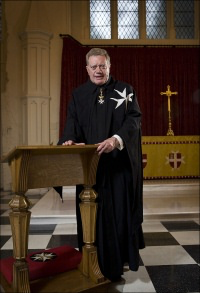
Such events did little to diminish the Order's prestige, however. The Peasant's Revolt was all but forgotten when Henry VII was named "Protector of the Religion." In 1517, Thomas Stanley, 2nd Earl of Derby, and Charles Somerset, 1st Earl of Worcester, were received into the Order as "knights of honour," a grade which did not require a vow of profession.
In 1527, the Grand Master named Henry VIII "Protector of the Religion," the title the Sovereign's predecessor had accepted. But royal favour was not to survive the winds of the Reformation, and Henry dissolved the Grand Priory in 1540. Several prominent knights of Malta were executed between 1539 and 1541 for denying the Royal Supremacy: Thomas Dingley, Adrian Fortescue, and David Gunston. William Salisbury and John Forest died in prison.
Queen Mary revived the English Langue in 1557, and Clerkenwell was restored under the Grand Prior Thomas Tresham. The Virgin Queen was less sympathetic. In 1559, Elizabeth dismembered the Priory and seized its lands and assets.
Today, the gatehouse of the old Priory of Clerkenwell is the seat of the Most Venerable Order of St. John of Jerusalem in the British Realm, which purchased it during the nineteenth century. In 1963, the Order of Malta and the Venerable Order (the latter was founded by Royal Charter in 1888) signed a joint declaration of recognition and cooperation, though there exists no historical connection between the two orders.
Despite the Reformation and the consequent dissolution of the Grand Priory of England, there were always English, Scots or Irish knights of Malta. Until the end of the eighteenth century, most of the Englishmen and Irishmen tended to join the Italian Langue, while Scots usually joined the French Langues. Titular Grand Priors were appointed, together with titular Priors of Ireland and Bailiffs of Egle. The Order was not without recusant knights, but the last titular Grand Prior of England, Girolamo Laparelli, died in 1815.
Edward VII received the honorary cross of a Bailiff Grand Cross of the Order of Malta in 1882; he wore it during a visit to Malta after his accession to the throne.
The Sub Priory of the Blessed Adrian Fortescue was founded in 1972, with Lord Robert Crichton-Stuart as Regent. Subsequent Regents included Andrew Bertie (the Order's Grand Master from 1988 to 2008), Viscount Furness, the Earl of Gainsborough, and the present Grand Master, Matthew Festing. In 1993, the Grand Priory of England was restored after being in abeyance for nearly 450 years except for titular Grand Priors.
The 56th Grand Prior of England, Frà Fredrik Crichton-Stuart, succeeded Frà Matthew Festing, presently Prince Grand Master of the Order, in 2008 and held the position until his death on 14 June 2011. The 57th Grand Prior, Ian Scott of Ardross, was installed on 13 October 2011. The Grand Priory's ecclesiastical seat is the Church of St. John of Jerusalem in St. John's Wood, London.
9/11 truth
switzerland![]()
3,000,000
over 3 million
hits a year
The 911 truth movement
has been corrupted
since it began
and only a few are still
honest and courageous.
Also the grassroots method
of organization
is vulnerable, unaccountable
and ineffective...
The Illuminati know this very well:
But who can you trust?
Knowledge is not truth
if there is no courage.
This should be clear
listening
to this interview:
Dr Judy Wood
Andrew Johnson
WTC Destruction
and 911 Truth Movement
Cover Up - TNS Radio
- 14 Sep 2010.
Perhaps the most
important interview
since 9/11.
Dr. Judy Wood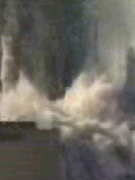
Right on target
since 9/11 about
Directed-Energy Weapons
(DEW)
Where did the towers go?
be sure to visit
drjudywood.com
by far the number one website on 9/11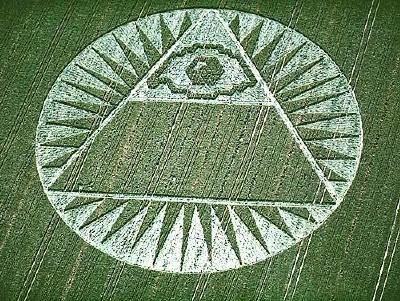
"One of the main techniques
for breaking morale through a
strategy of terror consists in
exactly this tactic--keep the
person hazy as to where he
stands and just what he may
expect. In addition, if frequent
vacillations between severe
disciplinary measures and
promises of good treatment
together with the spreading
of contradictory news, make
the cognitive structure of
this situation utterly unclear,
then the individual may cease
even to know a particular plan
would lead toward or away
from his goal. Under these
conditions even those
individuals who have definite
goals and are ready to take
risks are paralyzed
by severe inner conflict
in regard to what to do.
Dr. Kurt Lewin
(Tavistock's designer of the
OSS, the forerunner of the CIA) "
excerpt from 1991 John Coleman's:
CONSPIRATORS'
HIERARCHY:
THE STORY OF
THE COMMITTEE
OF 300
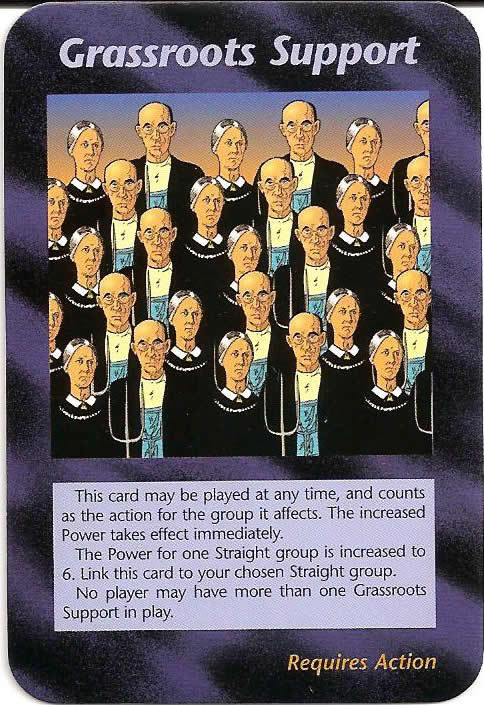
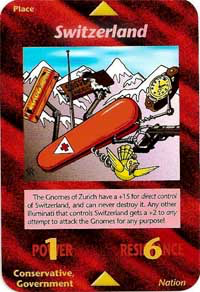
The Illuminati card game
is not a game
Video lecture
by
Andrew Johnson
Up to date 9/11
information,
integrity vs disinformation.
WTC incriminating and irrefutable evidence in 2 parragraphs
9/11 truth Switzerland : Europe's New president : Jesuit Herman Van Rompuy
on 2009/11/20 17:40:00
The winner is: The corrupted House of God, the Catholic church and the Jesuit Order of Malta, not the sovereign states of Europe
Jesuit Herman Van Rompuy 
"Van Rompuy gained substantial favour as a candidate for the new job of full-time European Union President relatively late in the game. It was his consensus-building skill holding a challenging coalition together at home which grabbed attention."![]() , really?
, really?
well no, not really, but that is what mainstream media will sell you, the truth however is far from surprising to those who know, how in a corrupt, docile and media mind controlled population democracy is on sale and can be bought by demagogues with, well , money:
Money says more than words, sometimes, like the Euro, it even says the word:
M A L T A
with its cross embedded on it, Malta is a word that says "more than words" :
If we haven't been hypnotized for the past few decades and if, we "follow the money", we arrive at the European central banks that deposit their assets 'along with the world's majority of central banks' in a PRIVATE consortium, a virtual central bank of all central banks B.I.S. in Basel Switzerland, and as savage as the washing machine BCCI (Basel Committee on Bank Supervision) , founded and funded by the Onassis, Rothschild and Rockefeller name lender's of the wealthiest institution of the world: Vatican City, if you still think Bill Gates is the richest man you really need to trash that T.V. already.
This bank has been used to finance the modern Jesuit crusades with the octopus arm of the Military Order of Malta, SMOM, CIA and its subsidiary Xe security corporation previously known as black-water.
Knights Hospitaller Sovereign Order of Saint John of Jerusalem of Rhodes and of Malta
The Jesuits within the Sovereign Military Order of Malta SMOMwith a permanent seat and powers at the United Nations that no other country enjoys, only that it is not a country, is protected by international law and sovereignty recognized by most countries, a privilege of virtual unaccountability with no borders, all rights and no responsibilities but to their master general (whomever that is since there appears to be secrecy of real hierarchy) .
(putting my sarcastic style in context and to the side, most readers will find these claims made up and shocking, if that is the case it is even more important to corroborate, these are indeed serious accusations that unless disproved, require action against a perilous repetition in history)
Prime Minister of the Kingdom of Belgium rome-pius is now crowned as the first president of the Kingdom of Europe. (There are even rumors that he is the anti-christ, and it would not be surprising that the antichrist, wether real or not, or antagonism to truth, play thing of the reptilian Gods would come from the Vatican's wolves in sheep clothes.)
( download and listen to this audio interview mp3 as an excellent introduction to the Jesuit Order of Malta)
Thus the embedded cross will be defended along and by the bank of central banks, I repeat:privately owned and Jesuit founded BIS, virtual owner of the way-too-BIG-to-fail central banks and their bonus with the taxes of the too-small-to-save Europeans, a victory for the reptile priesthood insatiable thirst,
and an ever bigger rip-off for you.
The world banking system is then coordinated by the Bank for International Settlements whose seat is in Basel, Switzerland, not the World Bank nor the IMF as usually led to believe but close enough still in the land of Heidi and nice watches.
BIS was created to support the Jesuit Eurasian crusade named World War II.
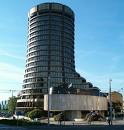
BIS tower in Basel
The alibi for its creation was the Treaty of Versailles: (Wikipedia) “…After World War I, the need for the bank was suggested in 1929 by the Young Committee, as a means of transfer for German reparations payments - see Treaty of Versailles….”.
In the German page of Wikipedia on BIS (translated below), they tell you explicitly: "During the Nazi age from ’33 to ’45 the BIS was considered a Nazi-friend bank with a strong German internal influential group. Emil Puh was both vice- president of BIS and president of Nazi Reichsbank. After the Austrian Anschluss (1938) BIS took the Austrian gold and was involved with the Nazi robbery of the Nazi occupied Tschoslovakey.
Norman Montagu, who was at the same time the president of BIS and of the Bank of England, didn’t obstruct the National-Socialist robbery. From the April 1939 the American lawyer Thomas McKittrick was drafter in the BIS in order to achieve a democratic façade. BIS worked as clerk for the financial business of the Third Reich.
The U.S. financial minister Morgenthau and the exiled Norway government tried to get rid of the bank (but Morgenthau was an Judenhof of the pope, he merely played a comedy).
The British minister for finance affairs opposed to the loosing stating that the bank was useful for the post war re-building of Europe. Only in March 1945 they decided to add a special realistic effect to their fantastic comedy, blocking the financial transaction of the Third Reich as “…the pressure of the U.S. government was no more avoidable by the Swiss !...”.
Wow! What a panic! In fact the past dealings of the BIS with the Nazis (BIS IS a Nazi bank…), vanished to re-appear only in the 90ies….”.
If you think the Nazi holocaust was the only and last one you should not miss this film at google video:
link here on the allies Nazi soviet collaboration film, The Soviet Story
if you dont have time to watch the film linked to right above,
listen this interview about current depopulation agendas taking place by the Jesuits, that will convince you to dig out more:
http://www.arcticbeacon.com/audio/200 ... RN/GSIJ.120109_070500.MP3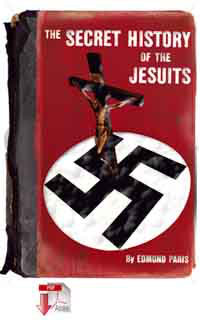
In Switzerland, the wars of XIX made the consequences of the roman way of the Jesuits "divide and conquer" obvious, people saw the "divide" was brainwashing people into hatred for each other to the point of killing their fellow compatriots in the name of God.
Two articles were adopted as exceptions for the constitution 51 and 52 where the Society of Jesus (Jesuits) was outlawed and hundreds of its members expelled .
For about 200 years the Jesuits tried hard to revoke the articles under the guise of "intolerance against catholics" rather than intolerance to an organization that had been caught red handed brainwashing and turning a polulation against itself. listen to this audio to understand how this mirrors the current events in the U.S.:
http://www.arcticbeacon.com/audio/200 ... RN/GSIJ.120209_070500.MP3
Finally the Jesuits, sometimes dressed as protestant priests, some times as politicians, (whatever it takes to fulfill their God given mission)succeeded in convincing the public that the horrors of WW2 were "created" by religious intolerance while completely disregarding that Hitler and Stalin were in fact pawns of the Jesuits.
In 1973 these articles were revoked for the sake of religious tolerance, all very fine...
But the controversy "somehow" reappears in 2009 manipulating the mind of people to see the beliefs of our Muslim compatriots with suspicion.
Of course "discretion" under the guise of "national security" about the lies of 9/11 and its war on terror not being addressed by our leaders and population seem to be having a big price to pay:
The steadfast destruction of sovereignty of Switzerland towards one world religion, one new world order with absolute power over beliefs and dissidence, the loss of freedom.
9/11 was a neutral job... Heidi
(*please note Switzerland's neutral policy is only regarding foreign armed conflicts)
Fernando Tognola
Geneva
2009/11/20
Other articles
2012/4/11 4:00:00 - United Nations exposed behind Syrian uprising
2012/3/20 16:50:00 - Earthquake in Mexico Illuminati card prediction
2012/2/14 2:50:00 - Whitney Houston conspiracy theory, ritual sacrifice coverup
2012/2/1 16:51:58 - Earthquake Projector
2012/2/1 15:52:36 - Early Warning
Site Suisse
en français:
http://11septembre.ch/
Contacts:
911truth.org
international contact list
Latest
- [2012/4/11] United Nations exposed behind Syrian uprising
- [2012/3/20]Earthquake in Mexico Illuminati card prediction
- [2012/2/14]Whitney Houston conspiracy theory, ritual sacrifice coverup
- [2012/1/24]September 11th The Occult Connection
- [2011/12/16] NDAA .pdf 911 truth darkest day
- [2011/12/8] MF Global Financial Collapse
- [2011/10/7] Occupy Wall Street protests a false flag potential for martial law
- [2011/7/22] 10 year anniversary: Oslo False Flag Terror Bombing Norway
- [2011/7/22] Judy Wood
- [2011/7/2]The film Zeitgeist and the damage it has done
- [2011/6/10]Builderberg Group provocateurs and corporate police trap in St. Moritz
- [2011/5/31] Alex Jones CONFIRMED gatekeeper and NWO provocateur
- [2011/5/2]Osama Bin Laden Killed on Illuminati May Day
- [2011/4/17] Lady Gaga Illuminati
- [2011/4/1]Bilderberg meets at St. Moritz "Never since 1163 had such an assembly of mass murderers, fanatics and dedicated perverters of the truth been seen"
- [2011/3/11] Japan earth-quake & tsunami hits on Madrid train bombings of March 11 2004 anniversary and 911 days after September 11 2001 anniversary
- [2011/3/2]Libya War Satanic Blood Ritual Spring Equinox
- [2011/2/10]Mubarak not steping down, CNN helps Egypt build up for violence
- [2011/1/10]Christina Taylor Green occult sacrifice fulfilled prediction
- [2010/12/3]WikiLeaks hoax
- [2010/11/23] South Korea False Flag Attack, celebrating Mumbai 2d anniversary of the attacks?
- [2010/11/9] United Nations hypocrisy and deceit on chemtrails.
- [2010/10/3] Europe False Flag Terror Alert Severe
- [2010/9/10] Bill Cooper murdered for predicting 9/11, but still speaking truth to power 9 years after september 11 2001
- [2010/6/18] South Africa World Cup false flag terror alert follows the EARTHQUAKE IN CHILE as the NWO Olympians welcome the FOURTH REICH
- [2010/5/31] Israel False Flag attack, Israeli commandos kill activists
- [2010/5/24] Alex Jones the deceiver claims Mexico is a failed state, here is why...
- [2010/1/30] Canada Olympics False Flag Terror Alert
- [2010/1/26] Martial Law in the works, EXECUTIVE ORDER Obama fear mongering and setting the stage for the Christian right to welcome the Armagedon End of Days
- [2009/12/17] The list of researchers and whistle blowers murdered grows
- [2009/12/15]Welcome to the new world order police state
- [2009/11/20]Europe's New president : Jesuit Herman Van Rompuy
- [2009/10/27]Jesuits Behind Latest Avian Flu Scare
- [2009/10/14]'Historian' claims 9-11 plot by Vatican, U.S.
- [2009/8/12] The Secret History of the World, The Society of Lizards, Vatican, Zionism, the illuminati and the masons.
- [2009/8/1]Leo Zagami reptilian shape-shifter? Video 2011 appears like Illuminati Card of 1995
- [2009/8/1]Ronald Reagan´s son Michael wants 9/11 truth activists executed
- [2009/7/31] What are chemtrails...?, clues from bill H.R. 2977
- [2009/7/5]Bill Cooper murdered, blamed on Alex Jones by Jeff Rense
- [2009/6/27] WTC IRREFUTABLE EVIDENCE in two paragraphs
1 comment:
The Above was written and approved when 911truth.ch was infiltrated by lies and disorder, since the site has dis-espoused the multifaceted lies blaiming the Church and the Jesuits for everything, the author has even reconverted to the Catholic Faith in great contrition. 911truth.ch webmaster
Subscribe to: Post Comments (Atom)
ARTICLE Archive
the jesuit vatican new world order

ARTICLE Archive
Awesome Inc. theme. Powered by Blogger.
